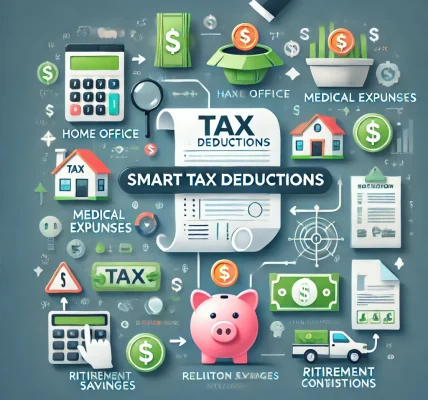When it comes to taxes, most people are familiar with the standard way of paying—based on their taxable income, deductions, and credits. However, for some high-income earners or individuals with specific financial situations, there’s a tax system that kicks in to ensure that they pay a minimum amount of taxes, even if they use many deductions or credits to lower their taxable income. This is known as the Alternative Minimum Tax (AMT).
While the AMT was originally designed to ensure that high-income individuals, who benefit from numerous tax loopholes, pay at least some level of tax, it can impact a broader range of taxpayers today. Understanding how the AMT works and how it may affect your finances is crucial for proper tax planning.
1. What Is the Alternative Minimum Tax (AMT)?
The Alternative Minimum Tax (AMT) is a parallel tax system designed by the IRS that runs alongside the regular income tax system. It ensures that taxpayers who claim numerous deductions or credits pay at least a minimum amount of tax, preventing high earners from avoiding taxes altogether.
The AMT operates by requiring taxpayers to calculate their taxes twice: once under the standard income tax system and once under the AMT system. If the AMT calculation results in a higher tax liability, the taxpayer must pay the AMT amount instead of the regular tax amount.
2. How Does AMT Work?
Under the AMT system, certain deductions, exemptions, and credits that reduce your taxable income in the regular system are either limited or eliminated. Here’s how the process works:
- Start with your regular taxable income: Begin by calculating your taxable income in the usual way, using your earnings, deductions, and credits.
- Add back AMT adjustments: Add back certain deductions and exemptions, such as:
- State and local tax deductions
- Personal exemptions
- Miscellaneous itemized deductions (e.g., unreimbursed business expenses)
- Calculate AMT income: After adding back these adjustments, you arrive at your Alternative Minimum Taxable Income (AMTI). This is essentially the amount of income on which AMT is calculated.
- Apply the AMT exemption: The AMT system provides an exemption that reduces your AMTI. However, this exemption begins to phase out for higher-income earners. For 2023, the AMT exemption is:
- $81,300 for single filers
- $126,500 for married couples filing jointly
- Apply the AMT rates: The AMT uses a two-tiered tax rate system:
- 26% on AMTI up to $221,300 for single filers ($331,200 for married couples).
- 28% on AMTI above these thresholds.
- Compare with regular tax: Once you calculate your AMT liability, compare it with your regular tax liability. If the AMT is higher, you will need to pay the AMT amount.
3. Who Is Affected by the AMT?
The AMT primarily affects higher-income earners who itemize deductions, particularly those with large deductions for state and local taxes, personal exemptions, or high numbers of dependent children. However, due to inflation, more middle-income taxpayers are becoming subject to the AMT. The following groups are most likely to be affected:
- High earners: People with high income who itemize deductions, especially in high-tax states.
- Individuals with large deductions: If you take deductions for state and local taxes, mortgage interest, or business expenses, you may face AMT.
- Families with multiple dependents: Those with significant personal exemptions may be impacted by AMT, especially as the exemption phases out for higher incomes.
4. AMT vs. Regular Tax System: Key Differences
While both systems tax income, the AMT and the regular tax system differ significantly in the way they treat deductions, credits, and exemptions.
- Deductions: Under the regular tax system, you can deduct state and local taxes, mortgage interest, and other personal expenses. The AMT disallows many of these deductions, meaning you could pay more in taxes.
- Exemptions: The AMT system limits or eliminates personal exemptions, which can reduce your taxable income under the regular system.
- Tax rates: The AMT has a flat two-rate system (26% and 28%), while the regular tax system has multiple tax brackets ranging from 10% to 37%.
5. How to Avoid or Minimize the AMT
While there’s no surefire way to avoid the AMT, there are strategies you can use to minimize its impact:
- Consider timing your deductions: If you’re close to the AMT threshold, consider accelerating or deferring certain deductions, such as state taxes, charitable contributions, or large medical expenses, to avoid triggering AMT.
- Invest in tax-advantaged accounts: Contributing to retirement accounts like IRAs or 401(k)s can reduce your taxable income, possibly helping you stay below the AMT threshold.
- Utilize credits: Some tax credits, like the Child Tax Credit, can help offset your AMT liability.
- Monitor your income: If you are in danger of crossing into AMT territory, consider ways to reduce your taxable income, such as investing in municipal bonds that are exempt from the AMT.
- Plan for capital gains: Long-term capital gains are taxed more favorably under the regular system, but under the AMT, these gains are treated less favorably. Planning the timing of your capital gains can help avoid AMT.
- Consult a tax professional: Navigating the complexities of AMT can be challenging. A tax professional can help you understand your exposure to AMT and develop strategies to minimize its impact.
6. AMT and Tax Reform: Recent Changes
Tax reform has altered the landscape of the AMT in recent years. The Tax Cuts and Jobs Act (TCJA) of 2017 made several significant changes:
- Higher AMT exemptions: The TCJA increased AMT exemptions, making it less likely for many taxpayers to be subject to the AMT.
- State and local tax (SALT) deductions: While SALT deductions were limited under the TCJA, they still play a role in triggering AMT for high earners in certain states.
- Tax brackets changes: The TCJA adjusted regular tax brackets, which could help offset the impact of AMT for some taxpayers.
While these changes have provided relief for some taxpayers, it’s still important to understand how AMT works and whether it affects your situation.
7. Final Thoughts
The Alternative Minimum Tax was designed to ensure that high-income earners pay a minimum amount of tax, even when they take advantage of various deductions and credits. While it was initially intended for a small group of taxpayers, inflation and income growth have made AMT relevant to more individuals today.




